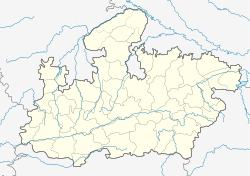Dhara (city)
|
Dhar Dhara |
|
|---|---|
| city | |

View of Dhār from the fort
|
|
| Coordinates: 22°35′53″N 75°18′14″E / 22.598°N 75.304°ECoordinates: 22°35′53″N 75°18′14″E / 22.598°N 75.304°E | |
| Country | India |
| State | Madhya Pradesh |
| District | Dhar |
| Elevation | 559 m (1,834 ft) |
| Population (2011) | |
| • Total | 93,917 |
| Languages | |
| • Official | Hindi |
| Time zone | IST (UTC+5:30) |
| Vehicle registration | MP 11 |
| Website | www |
Dhār (Hindi: धार) is a city located in the Malwa region of western Madhya Pradesh state in central India. It is the administrative headquarters of Dhar District, and was the capital of the Rajput Dhar State as Dharanagar from 1732 (previously the Raja had his seat at Multhan from 1728). The town is located 33 miles (53 km) west of Mhow, 559 m (1,834 ft) above sea level. It is picturesquely situated among lakes and trees surrounded by barren hills, and possesses, besides its old ramparts, many interesting buildings, some of them containing records of cultural, historical and national importance.
The most ancient parts of Dhār visible are the massive earthen ramparts which are best preserved on the western and southern sides of the town. These were probably built beginning in the ninth century and show that the city was circular in plan and surrounded by a series of tanks and moats. The layout is similar to the circular city of Warangal in the Deccan. The circular ramparts of Dhār, unique in north India and an important legacy of the Paramāras, is being destroyed by brick-makers and others using the material for construction purposes. On the north-east side of the town, the rampart and moat have disappeared beneath modern homes and other buildings.
The historic parts of the town are dominated by an impressive sandstone fortress on a small hill. It is thought to have been built by Muhammad bin Tughluq, the Sultan of Delhi, probably on the site of the ancient Dhārāgiri mentioned in early sources. One of the gateways, added at a later time, dates to 1684-85 in the time of 'Ālamgīr. Inside the fort is a deep rock-cut cistern, of great age, and a later palace of the Mahārāja of Dhār incorporating an elegant pillared porch of the Mughal period that probably belongs to the mid-seventeenth century. In the palace area is an outdoor museum with a small collection of temple fragments and images dating to medieval times.
On the overgrown ramparts of the medieval city, overlooking the old moat, is the tomb of Shaykh ‘Abdullah Shāh Changāl, a warrior saint. The tomb has been rebuilt, but the inscription, now incorporated into the compound gate, is written in Persian and dated 1455. A record of historical interest, it recounts the Shaykh's arrival in Dhār and his conversion of Bhoja to Islām after the local people had committed an atrocity against the small community of Muslims who had settled in the city in the earliest days of Islam. The story does not so much refer to the celebrated Bhoja but to a rising interest in Bhoja's biography in the fifteenth century and the attempts made at that time to appropriate his legacy in Sanskrit and Persian literary sources.
...
Wikipedia

